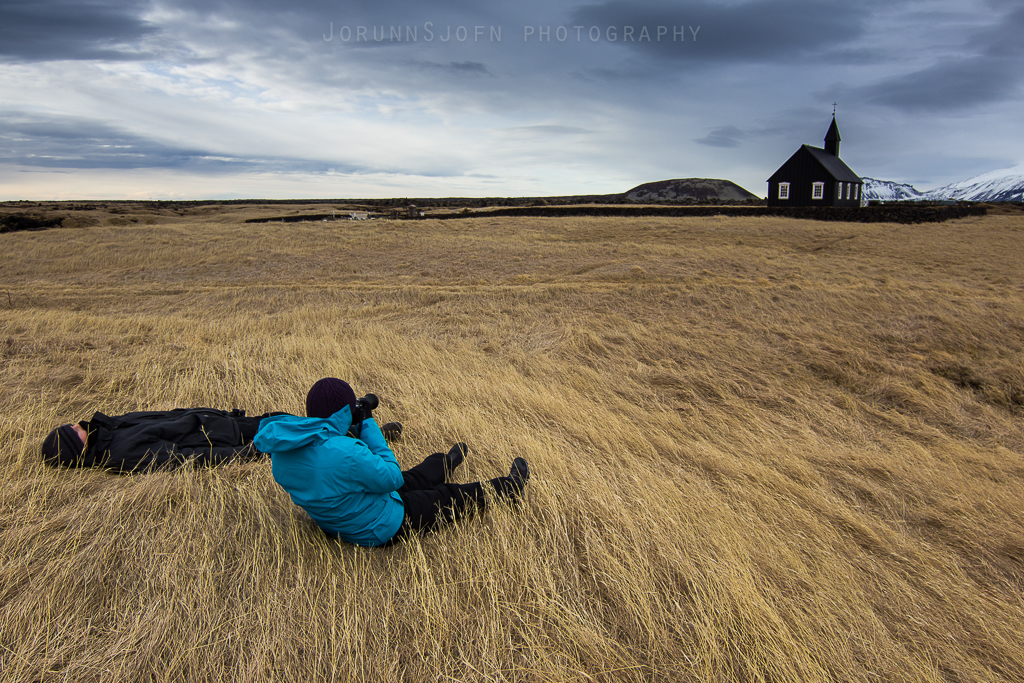Búðir
Búðir is located on the south side of the Snæfellsnes peninsula in Iceland. It is a hamlet consisting now only of a church and a hotel, but in the past played an important role as a trading center.
Transport links
The hamlet is located on Búðir an offshoot near the road 54 which extends around the Snæfellsnes peninsula, between Staðarsveit and Arnarstapi, where the road runs further 574 which surrounds the tip of the peninsula.
To the west of the road Búðir 54 performs as a mountain pass over the plateau Fróðárheiði after Ólafsvík in the north of Snæfellsnes.
History
Commercial space
For centuries, was in Búðir a very important trading place, which was about to 1930 inventory.
This fits in modern Icelandic also the name of the place, which would mean as much as shops.
Hraunhöfn
Even in one of the Icelandic sagas, the Eyrbyggja saga, the place is mentioned there, however, still under its old name Hraunhafnarós or Hraunhöfn. This name comes from the fact that Búðahraun were some cuts in the adjacent lava field that were considered particularly favorable landing sites. In the Middle Ages drove here with the boats in this small bays and the boats could come up high enough so that the winter storms they could not damage.
Winter fishing
About 3 km from the current hotel is Frambúðir. There you can see many ruins and remnants of earlier buildings today. The tracks date back to the 16th century. Here was winter fishing villages and trading posts. The name Búðir points to the winter fishing villages, which are called in Icelandic verbúðir.
Danish trading station
Until the Reformation in the 16th century, the land belonged to the monastery Búðir Helgafell on the north side of Snæfellsnes.
Then the Danish king appropriated the land and awarded from the establishment of the Danish trade monopoly 1602, the commercial rights to the end of the 18th century to its merchants. Especially a merchant of the Swedish- Danish peninsula spare, Bendt Lauridtsen, built on a trade and fishing center here. At the end of the 16th century, there were 100 people. Another important business magnate and fishing king of the area in the 18th century was Jacob Einarsson.
Problems at the end of the 18th century
At the end of the 18th century Snæfellsnes suffered greatly from the effects of the volcanic eruptions of the Laki. There was also a significant storm surge, called Bátsendaflóð in January 1799. Thereafter the village moved further inland away from the spot where today are still building.
In the 19th century
Furthermore, translation had rich merchants. One of them, Holger Clausen, left in 1836, even a stone house built, an unusual design for Iceland at the time. The house stood a few modifications until 2001, when it burned down, and was last used as a summer hotel.
In the 20th century
In 1906 Finnbogi G. Lárusson acquired the ground and directed it. In addition, he held a fishing operation until 1926 and a large agricultural sector.
After that, the state took over the grounds.
The current hotel was built Búðir 2003, but is based on the architecture of the style of the old stone house.
Church
The first church was built in Búðir in 1703 by Kaufmann Bendt Lauridtsen with the support of Bishop Jón vidalin of Skálholt. This church was closed in 1816.
A new church was built at the place again until 1848. It was renovated in the 20th century and laid in one piece. Today it is a protected monument as one of the oldest wooden churches in Iceland.
In it, a winged altar from 1750 with the image of the Last Supper is painted on wood.
Lava Búðahraun
The lava field is located west of the church and hotel. It is about 5,000 years old and flowed out of the crater Búðaklettur that belongs to the volcanic system of Snæfellsjökul.
In ancient sources say the lava field still Klettshraun. The rounded crater in its center bears the name Búðaklettur. It is 88 m high. It is believed that the lava has flowed here, as the water level in the sea was lower than today, so that the lava flowed in large part on dry land. Today, the sea level is so high that during storms and high tides sea water can be seen in many columns and pools in the lava field.
There are several cuts and coves in the lava field, including Keflavík - a common name in Iceland - and Selavík. The latter bears her name Seehundebucht not wrongly.
Many lava tubes and caves can be found in the lava field, including the largest, Búðahellir or Klettshellir called. To this cave are numerous legends, such as tendrils that a farm worker would have lost it and had returned in the Surtshellir on the Arnarvatnsheiði, about 200 km away, to light. A sprung criminals was again reached on the Reykjanes peninsula Reykjavík behind the surface, direct path about 150 km. A cat managed accordingly only to the approximately 5 km away Búðarós. After all, the stories remind suspect in the most famous novel about the neighborhood Journey to the Center of the Earth by Jules Verne.
Several Hornitos indicate that the land was probably not quite dry when the lava flowed out.
Geologists estimate the lava field for its composed of three types of rock cliffs of olivine, feldspar and pyroxene.
It is since 1977 under nature protection, but it also has an unusual for Iceland Flora, about 130 species of plants on, including 16 species of ferns.









